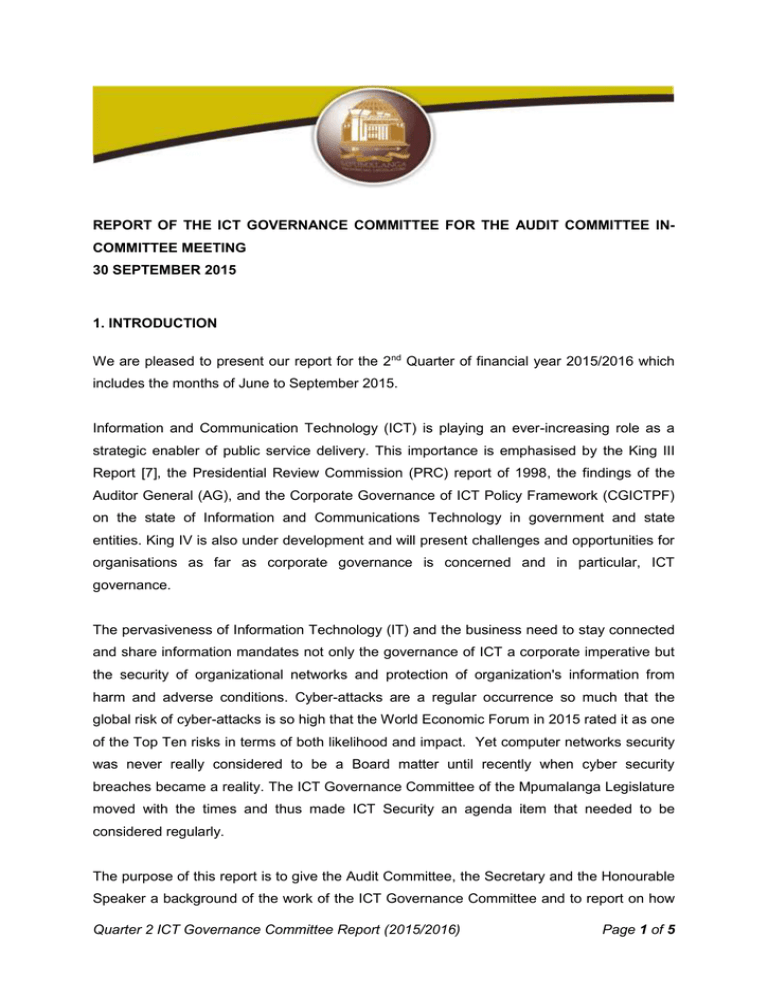Q2 MP Report of the ICT Governance Committee Q2 2015-2016
advertisement

REPORT OF THE ICT GOVERNANCE COMMITTEE FOR THE AUDIT COMMITTEE INCOMMITTEE MEETING 30 SEPTEMBER 2015 1. INTRODUCTION We are pleased to present our report for the 2nd Quarter of financial year 2015/2016 which includes the months of June to September 2015. Information and Communication Technology (ICT) is playing an ever-increasing role as a strategic enabler of public service delivery. This importance is emphasised by the King III Report [7], the Presidential Review Commission (PRC) report of 1998, the findings of the Auditor General (AG), and the Corporate Governance of ICT Policy Framework (CGICTPF) on the state of Information and Communications Technology in government and state entities. King IV is also under development and will present challenges and opportunities for organisations as far as corporate governance is concerned and in particular, ICT governance. The pervasiveness of Information Technology (IT) and the business need to stay connected and share information mandates not only the governance of ICT a corporate imperative but the security of organizational networks and protection of organization's information from harm and adverse conditions. Cyber-attacks are a regular occurrence so much that the global risk of cyber-attacks is so high that the World Economic Forum in 2015 rated it as one of the Top Ten risks in terms of both likelihood and impact. Yet computer networks security was never really considered to be a Board matter until recently when cyber security breaches became a reality. The ICT Governance Committee of the Mpumalanga Legislature moved with the times and thus made ICT Security an agenda item that needed to be considered regularly. The purpose of this report is to give the Audit Committee, the Secretary and the Honourable Speaker a background of the work of the ICT Governance Committee and to report on how Quarter 2 ICT Governance Committee Report (2015/2016) Page 1 of 5 the Committee had discharged its responsibilities in line with universally accepted principles of directors’ duty of care, that of ensuring that prudent and reasonable steps are taken regarding IT and associated risks. 2. BACKGROUND ICT governance can be defined as the set of processes, systems, governing structures that support an effective and efficient management of IT resources to facilitate the achievement of an organization’s strategic objectives and to ensure IT delivers value to the business and that prudent and reasonable steps are taken regarding IT risks. IT governance is divided into five main focus areas, strategic alignment, value delivery, risk management, resource management and performance management, all driven by stakeholder value (see Figure 1). . www.itgi.org www.itgi.org RESOURCE MANAGEMENT Figure 1 - IT Governance Knowledge Areas1 Strategic alignment focuses on ensuring the linkage between business and IT plans; defining, maintaining and validating the IT value proposition; and aligning IT operations with the enterprise operations. Value delivery is about executing the value proposition and ensuring that IT delivers the promised benefits against the strategy. Risk management is about addressing the safeguarding of IT assets, disaster recovery and continuity of operations. Resource management covers the optimal investment, use and allocation of IT resources and capabilities. Performance measurement, tracking project delivery and 1 www.isaca.org Quarter 2 ICT Governance Committee Report (2015/2016) Page 2 of 5 monitoring IT services, using balanced scorecards that translate strategy into action to achieve goals measurable beyond conventional accounting, measuring those relationships and knowledge-based assets necessary to compete in the information age: customer focus, process efficiency and the ability to learn and grow. The Corporate Governance of ICT Policy Framework (CGICTPF) is based on these knowledge areas, as well as principles found in the King III Code, ISO/IEC 38500 (family of standards for IT Governance) and COBIT 5 (an internationally recognised framework for IT governance). The CGICTPF stipulates certain governance practices for a government entity's Executive Authority, the Head of Department, the Risk and Audit Committee, the Executive Management and the IT Department. The Mpumalanga Legislature was one of the few entities to form an ICT Governance Committee as part of its governance and oversight structures and in that respect they are pioneers in their own right. At that time the CGICTPF was still not conceptualised and so King III, COBIT 5 and ISO 385000 standards became the guiding principles. The formation of the IT Implementation Committee (ITIC) a year or two later assisted in differentiating between a) the corporate governance of IT and the b) governance of IT. 3. NUMBER OF MEETINGS HELD The ICT Governance Committee held no meeting in the quarter: The ICT Governance Committee Report was presented to the Audit Committee on 31 August 2015, a transition period with the new Action Senior Manager: Information Technology appointed. 4. MATTERS TO BE BROUGHT TO THE ATTENTION OF THE AUDIT COMMITTEE AND THE EXECUTIVE AUTHORITY The following matters are brought to the attention of the Audit Committee and the Executive Authority: Corporate Governance of Information and Communication Technology Framework The CGICT Policy Framework was approved by Cabinet and the National Assembly and has not been approved by the Secretariat for implementation. The ISM Forum of the Legislative Sector has developed the Legislative Sector Corporate Governance of ICT Framework (LSCGICTPF). The Mpumalanga Legislature has also developed the IT Governance Quarter 2 ICT Governance Committee Report (2015/2016) Page 3 of 5 Handbook. Once all these documents are approved, the Committee will monitor and report on their implementation. The effectiveness of IT controls IT controls are designed to provide assurance that assets are safe guarded and that the confidentiality, and integrity, and availability of information are assured under all circumstances. The Committee, together with the Acting Senior Manager: Information Technology is working on a holistic approach of reporting on IT security matters. IT Risk Management Another important principle of King III is IT risks management and its inclusion in Enterprise Risk Management. The IT Risk Action Plan and the IT Audit Action Plan are being revised in line with the Committee recommendations. Business Continuity Business continuity enables the business to carry on their normal duties in case of any disaster. The ICT Business Continuity Plan will be done as part of the implementation of the CGICTPF and the Chief Risk Officer has been asked to lead the process. Disaster Recovery Planning The Disaster Recovery Solution and Architecture are being revised in line with the Business Continuity Strategy and Plans. ICT Strategy The IT Strategy has been completed and in the process of finalising handover issues and signoff. The Committee will then monitor the implementation of the strategy. 5. CONCLUSION The approval and adoption of the ICT Governance Framework for the Legislative and the ICT Strategy need to be concluded so as implementation can be monitored. Quarter 2 ICT Governance Committee Report (2015/2016) Page 4 of 5 Q2 was a period where an evaluation of the Information Technology activities and its projects was done in order to map the way forward. It was also a transitioning period with the new management defining the roadmap to address the inherent challenges. The Secretary and his team are to be commended for tackling the problems head on and developing strategies for addressing the challenges. ANNA BADIMO ICT GOVERNANCE COMMITTEE CHAIRPERSON Signed: 30/09/15 Quarter 2 ICT Governance Committee Report (2015/2016) Page 5 of 5




